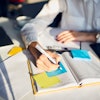
NEW YORK (Reuters Health), Mar 12 - With small breast cancers, doing complete axillary dissections only for positive sentinel lymph node biopsies (SNLB) yields the same 10-year disease-free survival -- roughly 90% -- as doing routine complete dissections in all cases, researchers say.
The report in the April Annals of Surgery shows that overall survival was actually slightly higher in women who had SNLB-based axillary dissection: 93.5% versus 89.7%.
The status of the sentinel node can accurately predict disease in the other nodes, but Dr. Umberto Veronesi, from the European Institute of Oncology, Milan, Italy, and colleagues wanted to know more about survival when women had no positive sentinel nodes and so did not have complete node dissection.
In a randomized trial that began in 1998-1999, 516 women who had breast-conserving surgery for tumors of 2 cm or less had complete axillary node dissection either routinely (n = 257), or only when sentinel nodes were positive (n = 259). In a 2006 update, the researchers reported that "only one overt axillary metastasis occurred during follow-up of patients who did not receive axillary lymph node dissection (whereas eight cases were expected)."
Now, with 10 years of follow-up, they report that 26 breast cancer events occurred in the routine dissection group and 23 in the SNLB-based dissection group. Ten-year breast cancer-free survival rates were 88.8% with routine axillary dissection and 89.9% with SNLB-based dissection.
Of 174 patients in the routine dissection group with negative sentinel nodes, eight had false-negative results. Based on this finding, the authors expected to see about eight false-negative cases in the SNLB-based dissection group, but only two cases were miscalled.
The researchers conclude: "The long-term breast cancer-related event-free survival in the (sentinel node-based dissection) arm was similar to that in the (routine dissection) arm, enabling us to affirm not only that sentinel node biopsy is as good as complete axillary dissection at staging the axilla, but that it is as safe as the once standard method of complete axillary dissection."
Ann Surg 2010.
Last Updated: 2010-03-11 15:40:09 -0400 (Reuters Health)
Related Reading
Contrast ultrasound makes for less invasive sentinel node staging, November 11, 2009
Axillary ultrasound can help avoid sentinel node biopsy surgery, October 8, 2009
Ultrasonography not a reliable replacement for sentinel lymph node biopsy, September 29, 2009
Copyright © 2010 Reuters Limited. All rights reserved. Republication or redistribution of Reuters content, including by framing or similar means, is expressly prohibited without the prior written consent of Reuters. Reuters shall not be liable for any errors or delays in the content, or for any actions taken in reliance thereon. Reuters and the Reuters sphere logo are registered trademarks and trademarks of the Reuters group of companies around the world.


















